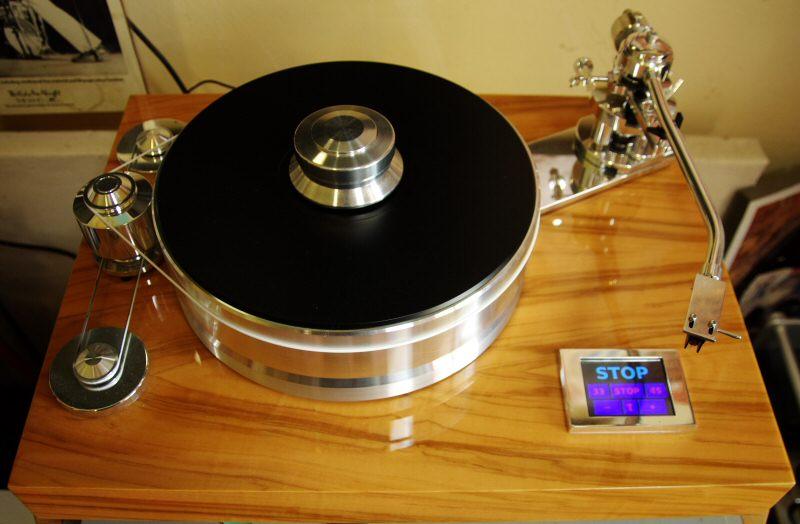Product: Pro-Ject Signature 12 Turntable
Manufacturer: Pro-Ject - Austria
Cost, approx: approx 10,000 Euro (YMMV)
Reviewer: Geoff Husband - TNT France
Reviewed: November, 2014
Introduction
Pro-Ject are a company that have been around a long time over 20 years. They arrived just when the world thought that Rega, with their Planar 2 and 3 had cleaned up the 'budget' Hi-Fi turntable market - then Pro-Ject came along to provide serious competition. From those beginnings, producing simple but well made turntables for the masses (and many newcomers to vinyl), Pro-ject have expanded with a bewildering range of turntables reaching ever higher up the cost/quality ladder. These continue to offer good value at each price point and with their turntables usually packaged with an arm of their own manufacture and, depending on market, a cartridge (normally Ortofon) a rather painless way for the customer to either enter, or upgrade in the vinyl marketplace.
This expansion upmarket has meant they start to take on some well established players and with their latest turntable they have made a serious assault on the high-end.
Which brings us nicely to the turntable and arm combination under review the Signature 12. Because this is a significant entry in the marketplace from a major player I've looked very hard at what the turntable offers. It's not been an easy review to write as so much of the design is unusual and the various design compromises taken need some explanation and frankly; criticism. I've tried to keep the result as coherent as I can and to impose a logical flow but forgive the occasional 'leaps' from one subject to another!
Construction.
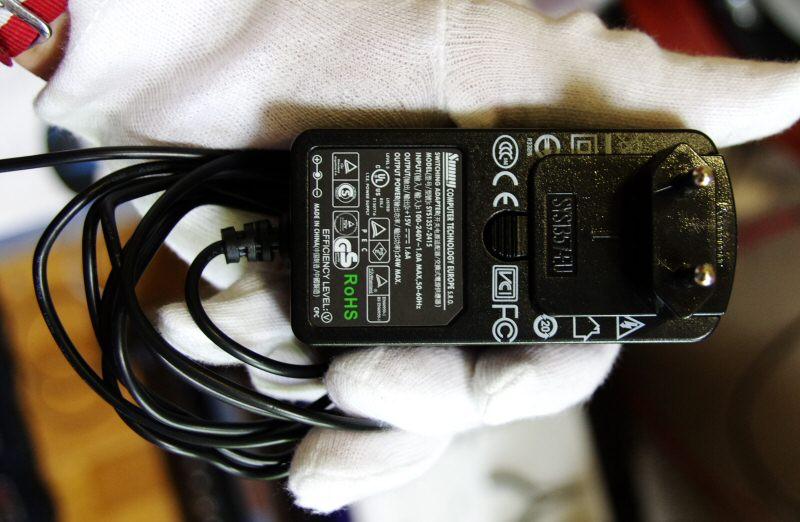
Looking at the photos you can see fairly obviously most of what you get. The plinth is MDF, veneered (there's a choice but the cherry of the review table was stunning) and routed out to take what appears to be the motor power supply, with the raw juice coming from a glorified wall-wart. Buried in this are two motors driving a flywheel-pulley and thence to the large alloy platter. The platter is damped both by some kind of hard polymer top surface (which the record sits on) and a strip of neoprene foam-rubber running in a slot under the platter. The result is a metal platter that doesn't ring unusual in itself. The bearing for the platter is inverted, comprising a steel shaft topped by a ceramic ball, it's surprisingly fine for such a heavy platter (10.5 kg of the tables 34 kg total weight) rather like Roksan's turntable bearings. An identical looking bearing supports the drive flywheel.
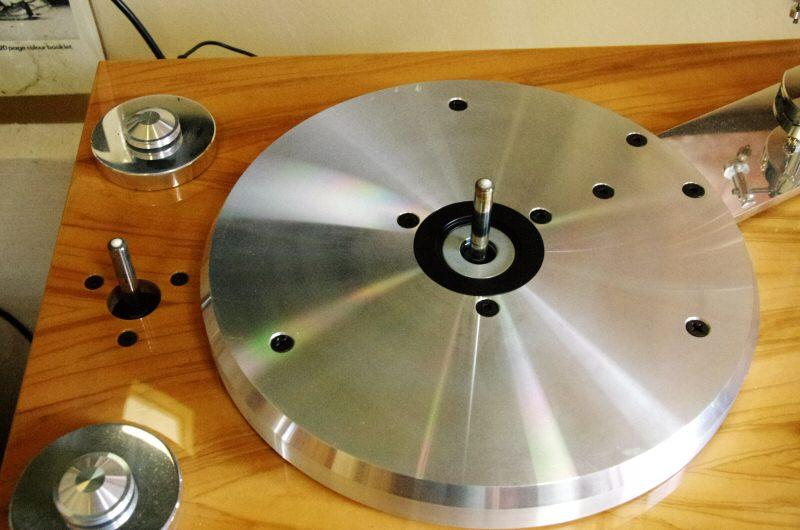
The platter bearing sits on a large sprung sub-chassis supported by some sorbothane 'pillows' and the arm, which is not detachable, is supported on an alloy outrigger directly from the sub-chassis this doesn't touch the plinth at any point despite appearances. Under the table are four very substantial spring feet using opposed magnets (more on this later).
The arm itself is a 12 'constrained' unipivot design with an S-shaped tonearm and SME headshell mount. It looks like some refugee from the 1960's;-)
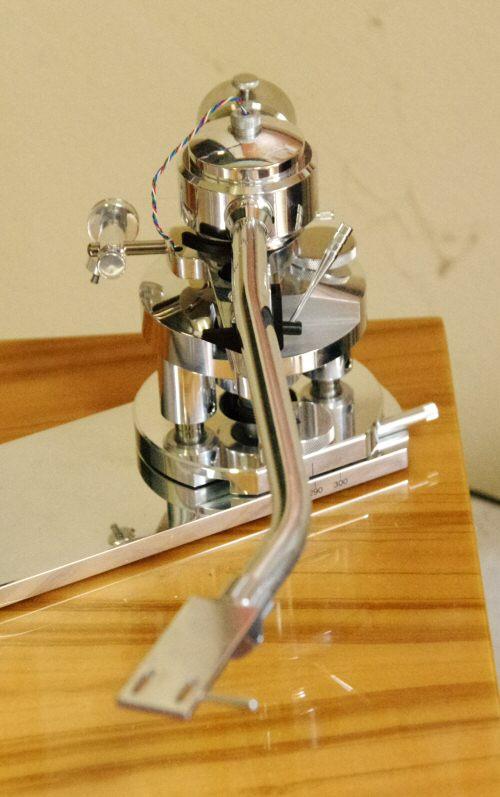
Control is via a large touchpad which my children thought very cool, but which couldn't be more dangerously placed for vulnerable cartridges.
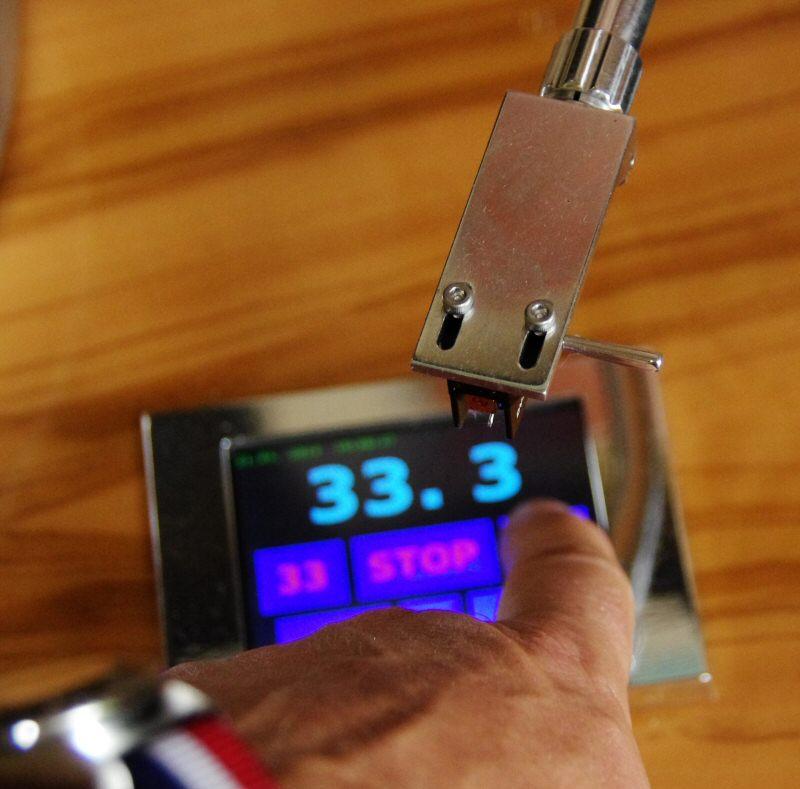
What all this doesn't tell you is the simply exquisite build quality. It is a gorgeous turntable, the polished alloy of platter, drive, chassis and arm all match. Work-of-Art wouldn't be an exaggeration and in a very strong field I have to say it is simply the prettiest turntable I have ever had here from the moment it was unpacked it drew nothing but very complimentary comments. The integrated nature of the design guarantees the aesthetic match. If you want a high-quality turntable that looks fabulous you need go no further...
Design
Having praised for beyond-criticism build we now come to the nitty-gritty of design, where compromises and choices are inevitable and where, in this case, those choices are often unusual.
First the turntable. One feature I have to address is the use of magnets in the design. Apart from the small magnet used to hold the arm in its rest position these are only used on the turntable itself. The platter claiming to 'float' on two opposing magnets, one around the base of the main bearing, the other on the bottom of the platter. In fact the platter does not 'float' and in my opinion a platter which can bounce up and down its bearing shaft is a dim idea anyway as it destroys the fundamental fixed relationship between platter bearing and arm pivot. No in actual fact the magnets are too small to lift the full weight of the platter but rather take some of the load off the bearing, which in theory should reduce wear/friction and thus noise. I don't have a problem with it.
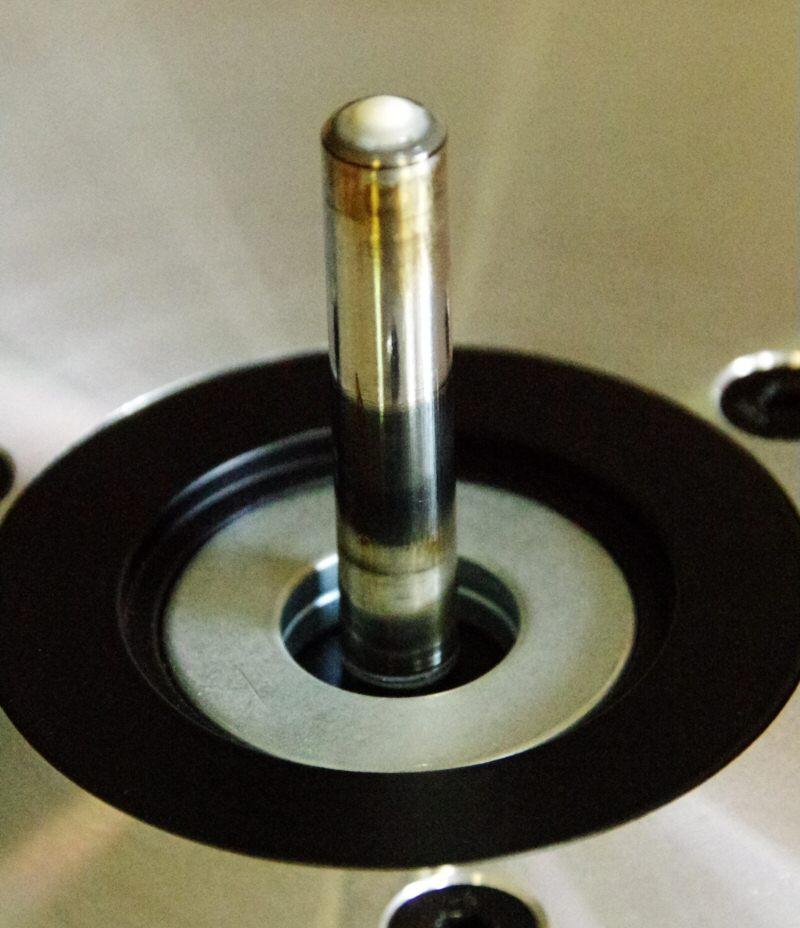
What I do have a problem with is the use of the magnets in the feet and far more so in the drive flywheel.
The problem with magnets -
The use of magnets as a suspension medium has been a lure for many Hi-Fi designers. By opposing two magnets N to N or S to S and pressing them together the force needed to bring them together increases. The attraction to the designer are obvious here we have a magic 'spring' that, because there are no physical components, cannot transmit 'bad' vibrations or 'ring' and so are the perfect isolating material. We've all played at this as kids the closer together they get, the harder they are to press together and the closer they are the more they want to slip to one side or the other to avoid each other. It is these two characteristics we discovered as a child that cause the problems.
The first is that though they mimic springs to some extent they minic very strong 'rising-rate' springs. That is they become stronger as they approach each other and the rate of increase is very steep exponential in fact. Now normally in a sprung sub-chassis the designer uses conventional springs which 'bounce' at a certain rate in order to tune the suspension. The rising rate doesn't allow this. In the Signature 12 the design uses 4 feet each set at the corner. Because each of these feet carries a different weight it means that to level the turntable they need to be screwed in or out a different amount. That means that the spring-effect in each magnet will be different (because of the rising rate), the bounce different and so its effect on isolation different for each foot. Using 3 feet correctly placed to even the load (why not!) - the characteristics of each foot would be identical.
So properly used magnets can offer good isolation? Well no because of our second infant discovery. Not only does the force needed to press the magnets together increase rapidly as they get closer the tendency to slip to one side becomes much greater. With strong magnets we all know that to push them to touch is impossible because we simply can't stop them slipping sideways.
So if you are trying to use magnets as springs you have to have some structure that forces the magnets to remain aligned, and as they come into closer proximity the structure comes under considerable lateral load as much as the total repulsion the magnets are providing.
If this structure takes the form of one tube or retaining ring sliding in another (as is the case in effect with the Signature's feet and flywheel) the forces acting on the walls of the retaining tube increases and with it the friction between the walls. This 'sticktion' is why you don't see magnets used as springs in cars. Because as the magnets approached, the friction caused by the sideways force in the supporting structure would 'lock' the whole thing up. Likewise on any isolation using such magnets in a turntable, as soon as the magnets take load the friction on the walls of the structure increases and as well as making the 'spring' jerky and not at all smooth it also means very strong contact between the parts of the supporting structure which instantly means vibrations can pass through them. Far from a 'magic cushion of force' you have a structure essentially locked in one position. True you can, as in the case of the Signature 12 feet, squeeze the feet further, but it isn't as smooth (more a stick->slip), than if you had simply used a blob of sorbothane - nor will it be as isolating.
To be fair to Pro-Ject I assume they tested both 3 and 4 feet configurations and sorbothane, solid and spring feet before their design decisions and chose the best sounding. If that is the case the the magnetic feet work despite their inherent problems rather than because of them such is the black-art world of vinyl...
The same cannot be said for the rather strange design of the drive flywheel it is just poor design. When I saw it I thought oh-oh! And my fears were more than justified.
This flywheel is constructed in two parts. An inner that sits on a substantial bearing (the same as the platter) and takes power from the two motors. Then slid over it as a sort of cup is the outer part carrying the pulley for the platter. Inside the 'cup' and on the top of the inner are magnets the idea being that the outer 'floats' on the inner so isolating the platter from the motor system. It's a stupid idea. Firstly the magnet will exhibit the same sideways thrust as the feet so that the 'cup' will lean one way or the other and essentially lock in position with any bounce being accompanied by the two walls grinding against each other. But even without this the pull of the platter drive belt is taken at the top thus pulling the cup to one side so that again it is in very intimate contact with the inner flywheel (i.e. none of the expected isolation). Worse still the whole structure has to rotate and so the outer will be continually rocking around the inner as the direction of pull rotates. As there is considerable clearance (inevitably it's far from a quality bearing) between the inner and outer flywheel this is basically going to rattle - so it proved. The drive system produced a continual knock-knock-knock! audible 3 metres away. The design will never offer any isolation and can never add anything but noise. It needs a rethink period.
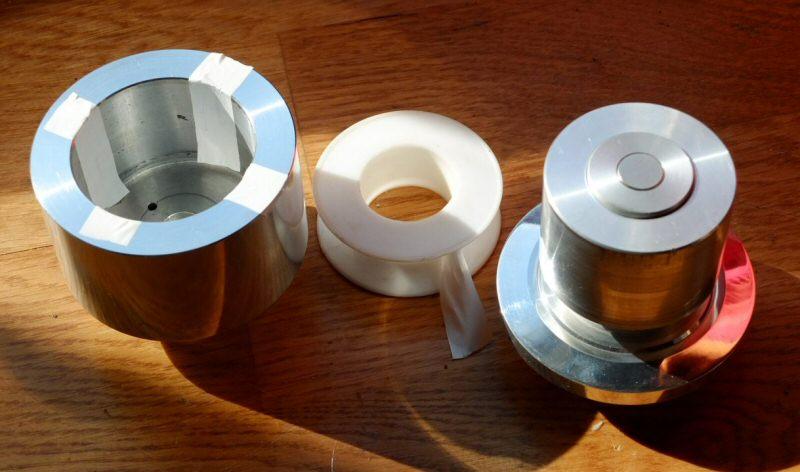
The good news is there it is an easy fix:-) The solution is to simply lock the two parts of the flywheel together. If the turntable was mine I would have been very tempted to fill the 'cup' with lead to a point where the outer sat at the correct height, or at worse something like plasticine, but as anything I did had to be reversible I resorted to the method shown in the pictures that any user can try without fear of damage. Just take PTFE tape (as used in plumbing and available in any DIY store) and place 4 strips as in the pics. Then just push the cup over the inner jamming the tape in the gap and demonstrating how big the clearances are... It takes 2 minutes to do. The result holds everything solid and the rattle from the flywheel disappears completely.
Drive System -
The mod to the flywheel being wholly successful I could look at the rest of the drive system. The system is similar to that used on some VPI turntables amongst others with two motors driving a flywheel which then drives the platter. The rearmost motor is mounted a little higher than the front so that the two belts have a straighter run to their respective flywheel-pulleys, but I was surprised that the motor height in both cases was below that of the pulleys so that both belts ran slightly upwards and so in theory would 'work' a little, theoretically producing more noise either this is a design/manufacturing fault or deliberate for some reason I can't fathom.
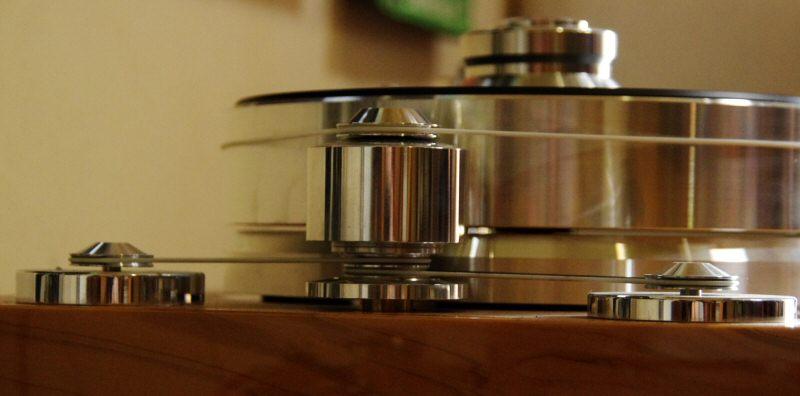
With two motors the platter got up to speed pretty quickly and after 15 seconds or so the touch screen showed 33.3. I'd like to think that this was a regulated speed measured somehow at the platter, but in fact it was obviously just a speed shown after a certain time as the same would happen with the belts disconnected;-) Using the touch screen and the supplied strobe disc you can get the speed exact but the odd thing is that if you have to correct the speed then the read-out will read a 'corrected' speed e.g. 34.2 even though it is now running at 33.33! That said the speed actually was 33.3 and never needed adjusting.
Even without the 'knocking' flywheel the motors were just audible it's not as quiet as the Feickert tables for example but here all credit to the design because regardless of volume at no time did I hear any breakthrough from the motors. This is a very good result that few turntables match every bit as good as the Feickert tt's.
The drive system excelled in another way I measured wow-and-flutter at between 0.02 and 0.01% an absolutely stunning result at the limit of my measuring equipment and the best I've had here - and at least partially responsible for what I heard later.
So a technically flawed drive system that performed flawlessly ho hum...;-)
Plinth and Platter -
As mentioned the plinth appears to be MDF routed for all the various components, but the heart of the turntable is the massive alloy sub-chassis and the projecting arm-board. Leaving the sub-chassis with it's transport screws in place resulted in a fairly microphonic plinth where a tap-tap! With a knuckle on the plinth got though to the disc with the suspension free this almost entirely disappeared so the isolation worked. The result was far, far better that the Opera and AS turntables I had to hand, though the Feickert Blackbird matched it quite comfortably despite the more simple plinth.
The main bearing, perhaps aided by the load taken by the magnets, showed extremely low friction, I got bored after a minute waiting for the unconnected platter to stop. As with the drive system the bearing was totally silent on record.
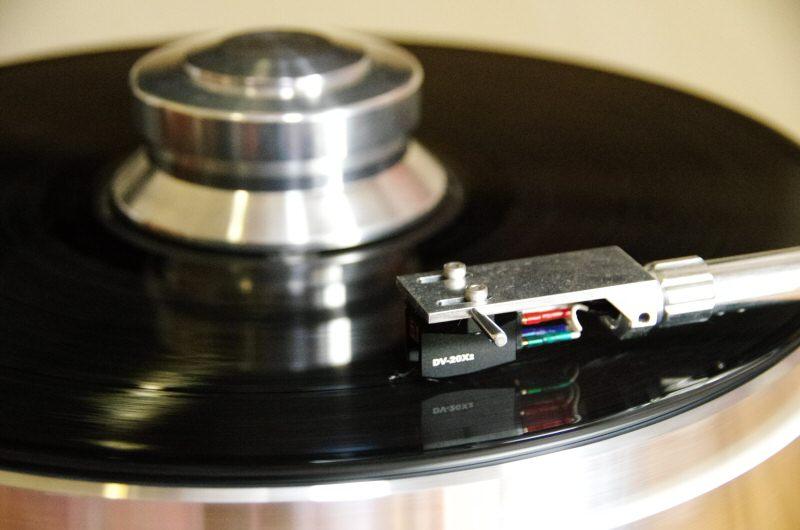
The tt is supplied with a beautifully matching alloy record puck, interesting as hidden within was a small plastic pin which was sprung so that at least some of the weight of the puck was taken on the pin. Such a tiny detail had be wracking my brains trying to figure out what it was for? Was it just to give a nice soft 'quality' feel as the puck was placed on the record. Was it to reduce the weight resting on the record if so why not just use a lighter puck? And of course the thickness of the record would alter the weight of the puck;-) But it's there obviously a design feature and must do something...
Control Panel -
My kids and their friends loved it (late teens early 20's). It was all part of the very retro/hi-tech dichotomy of the design; I hated it;-) First it was exactly below the cartridge so that the slightest lack of thought and you could wipe a few grand's worth of cantilever off your high-end MC, the one reason I never fitted the Dynavector DRT-1t... Second I didn't see the point of a screen that showed speed, or shouted 'STOP' when the turntable stopped and which with a push of the pad would tell you the time and date. I am also deeply suspicious of any gimmick that might stop working and leave you with 10,000 Euro worth of scrap. I want three nice high-quality switches/buttons ON/OFF, 33.3 and 45.0 maybe with something hidden somewhere to adjust speed. So many turntables screw this up the Feickerts have horrible rubber buttons, the AS a switch you have to reach over the turntable to get at, the Opera ditto. Ironically the Signature 10, lacking the extra space of the 12 has no touch pad, but instead exactly the sort of system I want!
My kids said I was wrong, that the screen would last forever and that it looked really cool. I'm 55 years-old next year and sometimes I can feel every one of them...
The Arm -
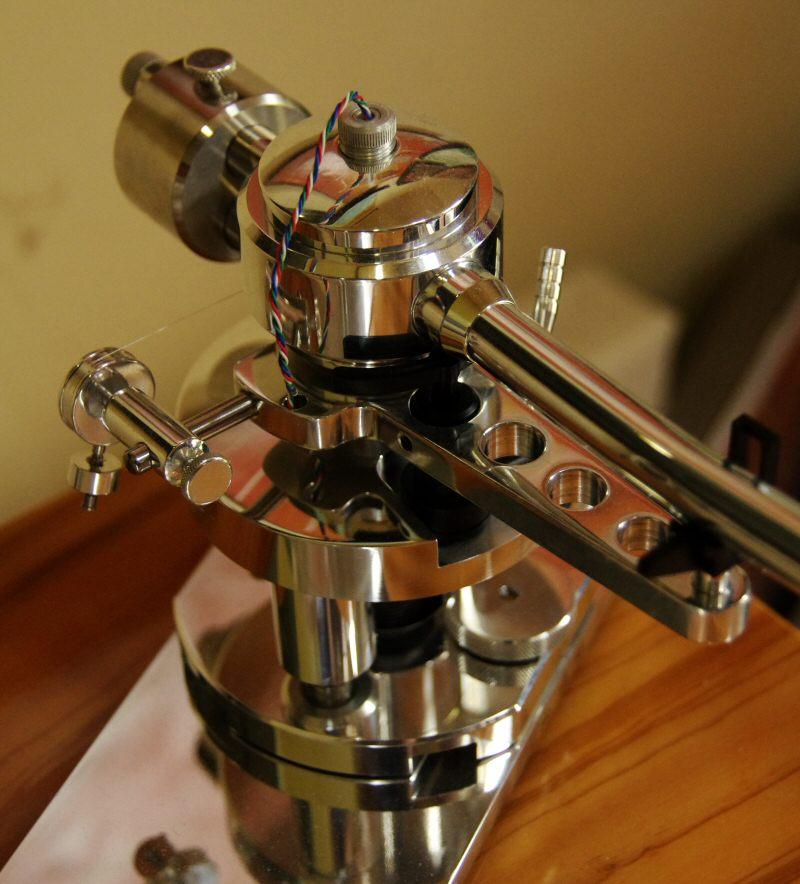
And whilst talking of 'cool', particularly retro-cool, the arm has to be one of the prettiest ever made. Finish is, like the rest of the turntable, beyond criticism. It also has the almost unique advantage of sitting on a turntable specifically designed to take it there is no option to use any other arm, nor can the arm be fitted to another turntable. Straight-away this potentially reaps huge benefits as the two can match not just aesthetically, but mechanically, sonically and physically. At the most basic level the weight of the arm should be a prefect match for the suspension and so-on. It's a rare treat for a turntable... The downside is that the combination has to be good because if the the arm is a weak area there's no hope of changing it.
All but the cheapest Pro-Ject turntables use a straight arm with a tapered carbon-fibre armtube. The better versions have more sophisticated bearings rather like the family of Rega arms and there is a 12 arm available. I was interested to see one in a publicity picture fitted to the Signature. These arms are conventional gimballed arms with classic correct geometry and mass distribution and follow mainstream accepted practice. The Signature 12 arm is the complete opposite. Despite looking a million dollars it flies in the face of much of accepted wisdom and shows no resemblance to the 'lesser' Pro-Ject arms whatsoever. I had to ask the question if Pro-Ject are already producing a well received, high-quality, conventional arm, why go to the trouble of producing a totally unrelated arm for their flagship turntable?
The arm is so unusual I find it hard to know where to start, but let's begin with the most obvious choice the designer has made one with huge knock-on effects the SME headshell connection.
This might seem trivial but not so... The SME or 'Universal' headshell was developed by SME in the 1960s and adopted by many companies for quality arms The connection comprises a threaded collar and a headshell that plugs into the end of the arm with a locating pin that the collar grips and then pulls tight into the arm as the collar is turned. It's a brilliant design that allows quick changes of headshells with little risk and maintaining all the alignments bar VTF. There are a million headshells out there with different masses and materials from ebony to Aluminium to Magnesium. It is thus widely compatible and was (note 'was') the industry standard, so much so that some cartridges were even built into special SME type headshells the most notable being the Ortofon SPU's that remain the reference for many even today. But nowadays it's used by only a tiny number of quality arms. Off the top of my head I can only think of the Ortofon arms, which resemble the Sig 12 in many ways, and the Dynavector 507 which is such a barkingly mad design you can hardly compare it to anything else;-)
There are a three obvious reasons why the SME mount has fallen out of favour. Firstly it inevitably adds weight to the headshell end of the arm, and any weight added there has a direct effect on effective-mass (EM). One gram added to the headshell = one gram on the EM and to compensate you have to lose many grams from the armtube - the result is an armtube less rigid than otherwise.
The second reason is that the mount adds an extra joint in the arm, this will inevitably compromise rigidity and of course any joint has both the potential to produce noise itself (essentially by 'rattling' at the microscopic level), and effect the way sound propagates and resonates within the armtube, as does the threaded collar.
Lastly you inevitably introduce not just a electrical pressure joint (where two contacts are simply pushed together) at the junction, but you are forced to use cartridge tags adding another pressure joint and a soldered joint, and of course a soldered joint inside the armtube to take the wire from the arm end of the connection. To put that in perspective an arm that uses continuous wiring from headshell to phono plugs (e.g. the Audiomods or SAT arms) has two pressure joints (cartridge tags and phono plugs) and two soldered joints per wire (ditto). Using an SME headshell at least doubles this. In fact the use of an armtop plug and din plug for the armwire means that the Signature 12 has at least 6 pressure joints and 8 soldered joints per signal wire. It is inconceivable that this improves sound it's just possible that it doesn't matter, but that's very much a minority opinion...
These are the widely accepted reasons for not using an SME headshell, but lesser known is that it also has just as fundamental effect of the geometry of the arm.
The problem is that the headshell joint is always, always at right-angles to the armtube. Everyone knows that a cartridge has to be mounted at an angle (the 'offset') to the stylus/pivot axis and yet no SME headshell allows for this because the SME standard assumes that rather than being straight the offset angle will be provided by bending the armtube itself into a J or S shape so that the headshell needs no offset of its own. This is why the Signature 12 arm looks so old fashioned, because it has to have a bent tonearm just like all the SME based arms from the 60's and 70's.
OK so what? Well the upshot is that this bent tonearm immediately compromises the geometry and mass distribution of the arm and the Signature 12 arm is a typical example.

Look at the picture of the Signature 12 armtube laid along the edge of a piece of paper to give a reference straight-edge. That straight-edge lies along the central axis of the arm between the centre of the counterweight and the pivot. Ideally (as with all other Pro-Ject arms incidentally) the stylus, pivot and centre of the counterweight should all be in a straight line. If the stylus is to one side any up or down force will have a twisting component on the armtube and the bearing. Now draw an imaginary line between the stylus position and the pivot. You see? All the mass of the armtube is now on one side of that line loading the bearing unevenly. True the counterweight is on the other side and may balance it but it's extremely unlikely that it will perfectly, as only true unipivots show this balance point, and even if balanced the dynamic behavior will still be twisted.
How significant these errors (and they can be nothing but) are on actual sound quality is a matter of debate, and also dictated to a certain extent by the bearing design unipivots cope badly with such a design because it makes them wobble! - but having an arm continuously trying to twist is not going to be perfect for any bearing least of all the rather strange bearing of the Signature 12 as we will see later.
So with all this now widely accepted why on earth did Pro-Ject choose the SME mount with all the compromises it brings.
1 perhaps after extensive testing (after all as I've said Pro-Ject make a perfectly correct and successful 12 arm) Pro-Ject have decided that accepted practice is either rubbish, or perhaps more likely insignificant to sound quality at this level
2 There is something very aesthetically pleasing in a retro-cool way in a well curved tonearm;-)
3 The ease of set-up and cartridge changing is something they feel will weigh heavily with their target market, the well-heeled audiophile who values convenience as well as sound quality one reason they might want a 'package' like the Signature 12 rather than hunting down separate arms and turntables.
4 With their links to Ortofon they wanted to allow owners to fit classic SPU cartridges. In fact this was one of the cartridges recommended to me by Pro-Ject for the test. This is certainly why the Ortofon arms retain the SME fixing. I've not had one of the Ortofon arms here on test but I wonder if there may be more than a little cross-fertilization between the two.
I suspect that like all things Hi-Fi, here we have a compromise between all 4. Pro-Ject haven't got where they are today without how to put together a good package that it may offend my purist leanings means nothing...
The Arm Bearing -
Which brings us to the next controversial aspect of the design the bearing... This is what I call a constrained-unipivot. The main bearing of which is a normal unipivot on an upwards facing point in a cup in the removable armtop. So far so good. Such a design would normally be in some trouble given the nature of the arm's geometry, but if you look at the underside of the arm-top you'll see that instead of the round aperture you'd expect (allowing movements in all planes) you see a slot which only allows the arm to go up and down any sideways movement is 'constrained' by the walls of that slot.
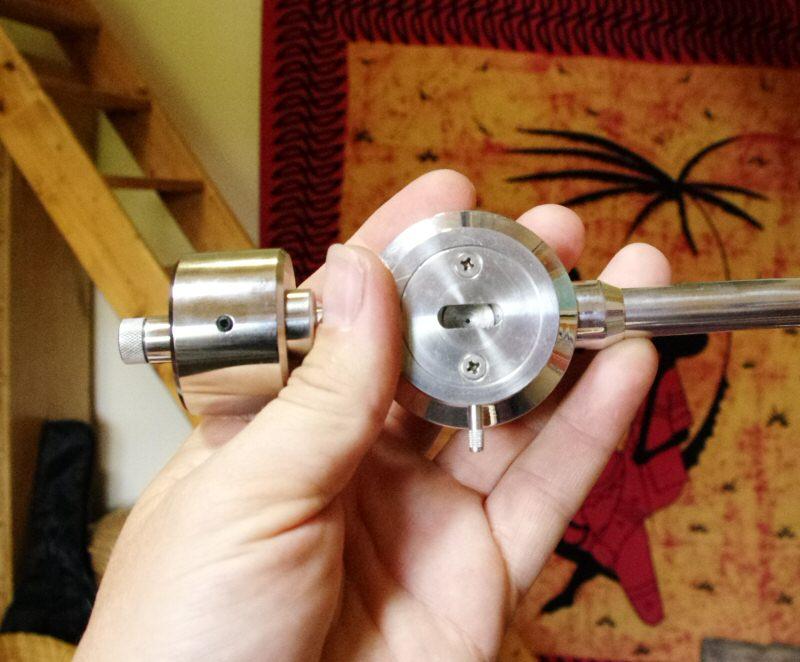
I have to say I'm not too happy with this design. For it to work the slot has to be a tight fit around the shaft of the bearing. If there is any play then the arm will rock from side-to-side (again especially with the geometry used) and 'rattle' against the bearing shaft. To add to this the shaft is (I assume), tool steel and the walls of the slot in the arm Aluminium and so we're talking about direct metal-to-metal contact. So if the clearances are very small we have a sliding, metal-on-metal contact every time the cartridge rises or falls. I know of no other arm that uses anything remotely like this for the simple reason that you need a proper bearing here a ball-bearing race, a knife-edge, points or whatever to rely on one piece of metal rubbing against another seems bizarre. As there is no way of knowing if the arm is laterally balanced or not it is inevitable that the arm will spend most of its time rubbing on one side only of that slot. The bearing shaft appears to be coated with some black substance. There are some very high-tech coatings available now (DLC 'Diamond Like Coating' for one) which have very low friction and are very hard but I suspect this is Teflon because the coating was already wearing through in places (see pic).
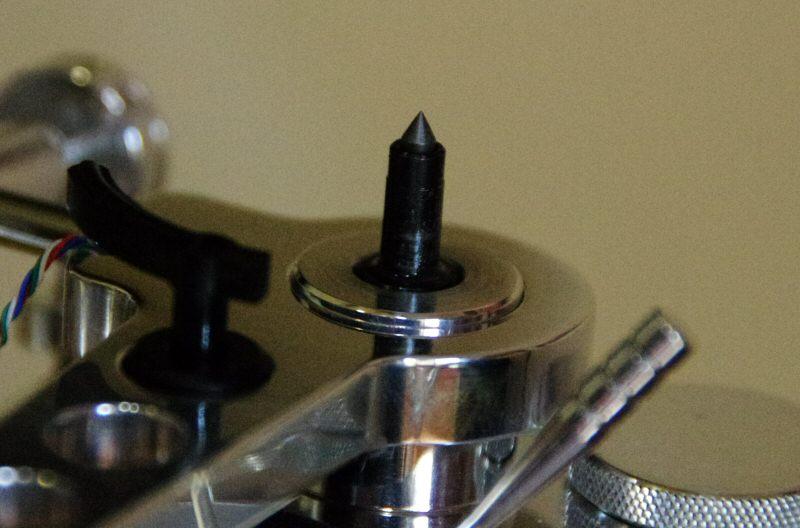
When I set the arm up I did do the 'float' test to check bearings by setting a zero VTF the result was that moving the arm it would just sit wherever it was put in the vertical plane rather than 'floating'. Adding a small amount of VTF (which of course was impossible to measure) by moving the counterweight a fraction didn't help. So as I suspected the bearing shows high levels of friction this will produce noise and effect the cartridge over warps.
When I said ' I know of no other arm that uses anything remotely like this' what I didn't say was that I have used an arm now out of production that used an almost identical bearing very successfully but the 'almost' is critical. The arm in question was the Audiomeca Romeo. This too was a constrained-unipivot but a tiny detail made it work brilliantly.
On the Romeo the slot was much bigger than the bearing shaft and the arm was a pure unipivot. As with any unipivot worth having it had a lateral weight that balanced the arm in the horizontal plane. But for those people who wanted an arm without unipivot 'wobbles' there was a small Delrin Sleeve which went over the shaft of the bearing. This was precisely the same diameter as the slot in the armtop so now the effect was exactly like the Signature 12 arm the differences being that the bearing was metal (armtop slot) to Delrin plastic (very low friction), a much quieter combination, but just as important, because the arm had been balanced already as a unipivot the sleeve had no force on it at all once the record was cued it just acted as a 'steady' when needed, didn't need to be so tight, would not wear and wouldn't be noisy. Audiomeca recommended that for ultimate fidelity the sleeve should be omitted but the difference was marginal.
Arm Set Up -On a more positive note the arm was a pleasure to set up. The arm base obviously doesn't need a traditional arm-board but still has a sled rather like the SME V which allows it to be racked back and forth with great accuracy. The counterweight stub carries a thread which engages in the counterweight so that it too can be racked back and forth easily then locked with a grub-screw. The counterweight is in two parts with a choice of sub-weights fitting into a hole allowing you to position the counterweight right by the bearing to reduce EM. The counterweight is also underslung and can be twisted on a unipivot this would allow the arm to be statically balanced laterally, but unfortunately on the Signature 12 arm it only serves to load one side of the bearing more than the other there is no way of knowing which. The counterweight-stub appears to be decoupled with some flexibility in mounting which again is very much against current thinking and a throwback to designs from the 60's from Lenco and the like.
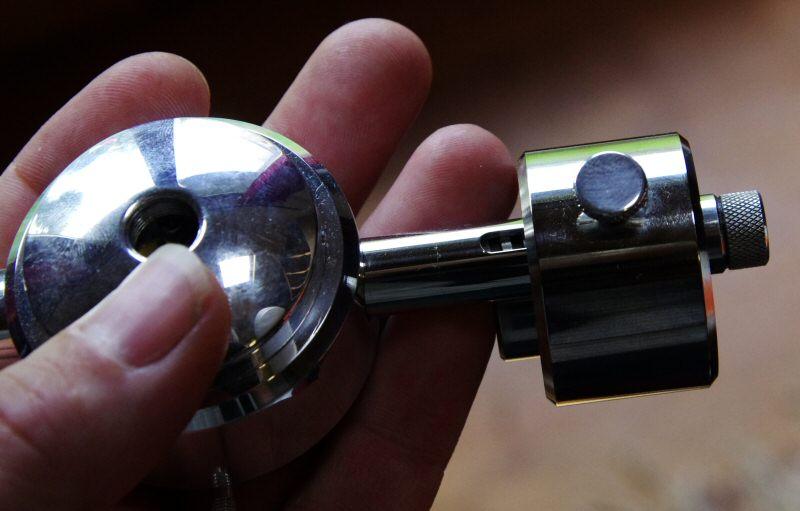
Anti-skate is provided by a nice pulley/weight arrangement though the thread then pulls on the bottom of the arm-top well below the unipivot, which will then in turn pull the arm to one side of the bearing slot having the thread at pivot height would have eliminated this.
Arm height was adjusted using a threaded wheel after first having undone two grub-screws this system allowed adjustment during play for those into this sort of thing and once locked up was considerably less compromised than some arms with such a facility, though there were no micrometer markings.
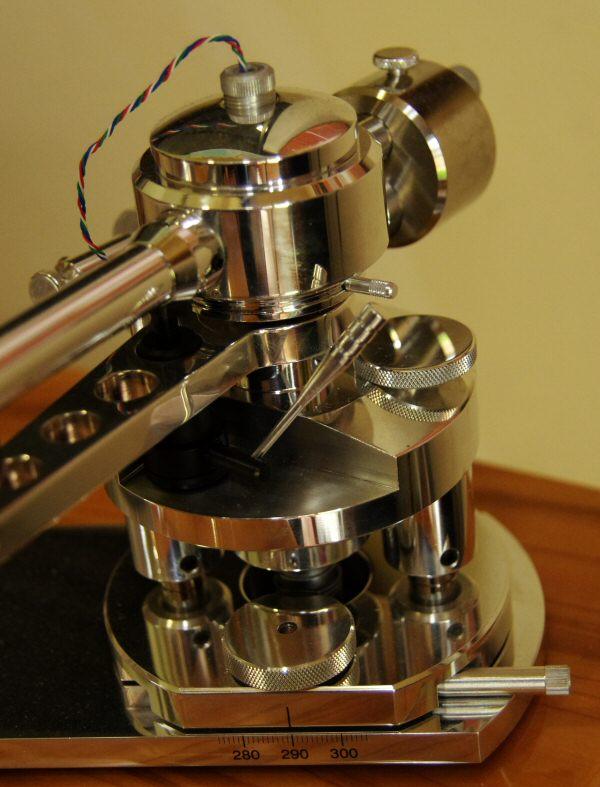
The turntable came with a whole range of gadgets for adjusting the arm - stylus pressure gauge, templates and a very nice alignment tool (Pro-Ject Align-it, similar to the Feickert Protractor). All very welcome.
Azimuth could be adjusted at two points the supplied headshell had a built-in collar and grub-screw arrangement allowing the headshell to be twisted and further compromising rigidity and EM this proved useful as in the sample (and obviously a sample fault from a hard-used review table) the SME fitting was misaligned and so the headshell had to carry a correcting angle to be perpendicular. Unfortunately this meant I couldn't use my other headshells, which would have enabled me to play with EM as well as making cartridge changes easy.
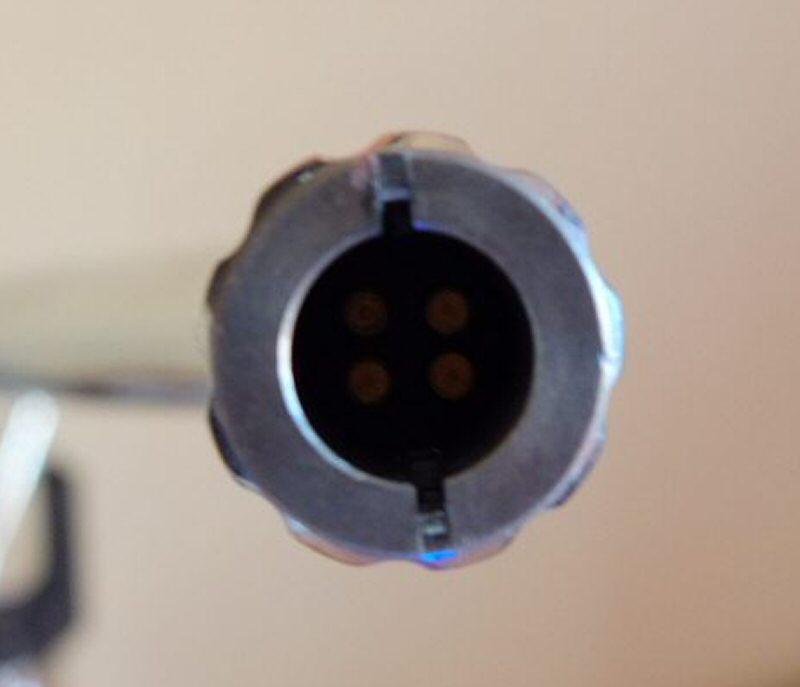
At the end of the armtube is another grub-screw which loosens the whole armtube so that it can be rotated to alter azimuth. It's almost as if the designer has concluded that rigidity isn't a characteristic worth chasing! Interesting...
The spec sheet put the EM of the arm at 19.5 grms which is pretty heavy for a modern arm (the V12 is 12 grms) but looking at the construction believable, and just what you want for vintage cartridges like SPU's. The recommended cartridge weight is 4-10 grms which of course excludes all such cartridges (the SPU = 30 grms!) and many other high-end cartridges such as my DRT-1t and which I can only assume is an error in the spec.
For the test I mainly used an Ortofon x5 (4 grms) and a Dynavector 20x2 (9.5 grms) both of which gave a reasonable arm/cartridge resonance of 9-12 Hz which rather belies the EM figure neither had any problems quite the opposite as we will see...
Sound Quality
Well congratulations to those who are still with me;-)
Having spent a fair few of those words criticising various aspects of the design, some of which I find quite baffling, I now have to start eating humble pie because as the Signature 12 is a turntable that very nearly didn't escape from my listening room...
I started with the Ortofon cartridge it's a cheapo MC but good for getting the feel of things, and from the moment the needle hit that first groove I was smiling;-) Why? Because instantly this turntable, a real 2014 product with touch screen and gloss, took me back to my first experience with a really good turntable 30+ years ago a Linn LP12;-) Now I know some of you (and Pro-Ject) might not see that as much of a compliment, but bear with me. The one thing that a good LP12 does is have fun with music. It bounces along merrily, it plays-a-tune, follows-the-rhythm, keeps-with-the-beat... The Signature did all that but to the power of three.
Sometimes I'll review new component and think just listen to that detail, or wow! - the 3 dimensional sound-stage all great, and then after an hour I'm sort of getting bored. What came from the Signature was lush and powerful, effortlessly dynamic, full of technicolour fun and drive. I was smitten. After 15 years of reviewing I'm often in danger of becoming seriously jaded and yet the Signature is one of the few components that reminded me of the reason I listened to music in the first place it isn't some intellectual exercise - it's supposed to change your mood, your emotions, it's meant to make you start spreading album sleeves on the floor; and all this with a cartridge costing the same as 5 new albums...
I really wanted to see what a more appropriate cartridge would do and because I'd decided against my Dynavector DRT from fear of damage I contacted Dynavector and bless them, a week later the Dynavector 20X2/L dropped through the post-box and apart from not being shiny alloy proved the perfect match.
Over the next two months I spent more time playing vinyl than I have in a long time it rekindled my enthusiasm for music in general and in turn got me listening my other turntables as well. Once the initial euphoria of a new sound has worn off it all needs to be put back into perspective and here I have some very serious competition so now, in a more sober mood I will try to put across what the Signature does, what it doesn't do and why it is important.
Given it's elevated price I thought it only fair to compare the Signature directly with my current favourite turntable, the Dr Feickert Blackbird. The two have a lot in common. Both are from established companies (though Pro-Ject is many times bigger) and they aim at a similar price-point. The Blackbird, at 5000 Euro doesn't have an arm but add my SME V12 and you are very close to the Signature's price. Both use two motors, the Blackbird can take a second arm and has the flexibility to take just about any arm on the planet, but in the context of the package and the market Pro-Ject are aiming at that's not important. Sure if you want to run two arms, swap to other arm manufacturers, generally mess about with the whole set-up then the Feickert has it, but if you just want to play music then they are direct competitors.
Both are beautifully built the SME V12 an engineers arm in particular, but for pure looks and polish the Signature walks it. If you want to impress your (uneducated) friends or want a work of art to enhance your Mayfair flat then Dr Feickert isn't going to get your cheque.
But the Blackbird and SME together have such an integrity you could think they did come from the same manufacturer, and the result is something that though it might not blow you away on first appearance will become something to admire over the years. In appearance as well as sonically the two turntables are a long way apart...
So let's look at where the Signature scores over the Blackbird. The whole foundation of that fun presentation is a unique way with bass. Record after record threw out lovely, fruity bass lines that normally were 'there' now they were THERE! I'm not talking about some ghastly X-Bass or a one-note boom-box (and the dear-old LP12 is just a little guilty here) the bass is fantastically fast and tuneful and no overhang and just sings along. I started listening to old records I'd not played for years to see how the bassist drove things along records I play most weeks and know backwards now they had bass lines that made me sit-up and take notice. I literally had 'boogie nights!'...
The Blackbird picked out all those bass-lines too of course it did, but it didn't make them jump out at you in the same way. I feared I'd get bored with this, but because it wasn't at all like just bumping up the sub-woofer, but rather a cutting into the core of music I never tired of it.
Massive dynamics, brilliant tunefulness, fabulous timing, great attack for percussion and bass. None of this was bloated, or overwhelming or coloured. The downside was that with all this going on other things inevitably became less prominent. It wasn't as if it was missing important things, but rather vocalists, female in particular got pushed back from centre stage as the bassist strutted his/her stuff. Having been eclipsed by the Signature, the Blackbird's incredible even-handedness shone through, you have the impression that the Blackbird takes a more intellectual view of events, perhaps closer to the studio's original intention, whereas the Signature is giving you a technicolour version complete with fireworks.
This extends to their respective soundstage the Signature feels big and expansive and extrovert, the Blackbird controlled and precise and detailed. The Signature doesn't match the depth the Blackbird/SME can generate, nor the exact placing of instruments just as the Blackbird can't produce the feel of being at the front row of a UB 40 concert at the threshold of pain.
This is really meant to be a review of the flagship Pro-Ject turntable, and I feel a bit guilty for making it into some kind of head-to-head with the Blackbird, but there is another reason. You see the Blackbird is universally well reviewed. In my system it's the best turntable I've heard (and I've heard a lot just look at the reviews on TNT) but it arrives at that point of excellence by being better at the things other turntables also target. The detail, the balance, the soundstaging, the control, the extracting of information from the master-tape, the reproduction of subtle phrasing and harmonies. All these are what turntable manufacturers have been striving for and currently, in my limited experience the Blackbird is top-of-the-pile.
But the Pro-Ject doesn't even try - the arm ignores all the world has learnt about arm design, the way it 'edits' music to produce something fun and engaging and visceral is nothing short of remarkable. It's silent background and utter speed stability obviously help a great deal in this.
The only thing that comes close is when the Blackbird was fitted with the SAT arm an utterly state-of-the-art, modern Carbon-Fibre arm that would triple the cost of the Blackbird and make a combination over twice that of the complete Signature (though superior in almost every respect). I can't begin to imagine what it would do on the Signature perhaps it would kill the magic or blow my mind I'm never going to find out. Likewise if the Signature 12 arm was a true unipivot using a straight arm and no SME mount would it be better or worse?
In the end the Signature does trail in ultimate detail. It's not that there's so much going on that the tiny details get lost in fact all that bass and dynamics are so impressive because they come out of a black, solid background leaving lots of space for the rhythms to breath it's that in that space some stuff gets lost feint echos, whispered lines, that little 'ting' in the background. The Blackbird/SME does all that and still make you dance but the cost is that your heart rate just won't be as high.
All this would point to the Signature being a 'rocker's/dancer's' turntable but I'm not sure. Though some subtleties of 'Time Out' or 'A Kind of Blue' (I know you'll have those) were lost, the basis of all Jazz is rhythm and so both these and many other jazz records were gorgeous to listen to. Classical doesn't major on timing, but it does on dynamics and again the pushing back of detail was counter-balanced by the scale of the orchestra.
Where it did suffer most was in some of the smaller scale classical, chamber orchestra, and somehow opera often seemed to have the singers just too far backstage, but you'd have guessed that anyway.
Conclusion
I apologise to those who like lists of what violin I've heard on what disc, but this isn't that sort of review. The Signature is so different from most of its competition in both concept and execution that I can only hope that I've managed to convey in some way what made it a very special experience to me and made me start to explore music again. Because I can't separate arm from turntable I have no idea which part is responsible for the good things and which for the less-good, such is the nature of the beast. In one respect this is frustrating, but in another rather 'Zen' I can't do anything about it and so just judge the unit as a whole, I feel that is what customers will do too.
Though it is not a turntable for everyone, it is even-handed enough not to be hyper system critical, and likewise it is not an intellectual turntable in the mold of the Blackbird and most other competition in its price range. A 'fun' turntable seems to be rather a negative comment for a 10,000 Euro flagship bringing up images of Pro-Ject's lower end products with their coloured plinths, but the reality is that such turntables are not remotely 'fun' in the way that the Signature is and they generally tend to be pale shadows of more expensive turntables sad but true. 30 Years ago the Linn LP12 survived as a top turntable despite being less than even-handed or capable as other turntables simply because it was fun to listen to. The Signature returns to that central premise and hugely expands on it. I don't want to give the impression it's bad at detail or soundstaging or female vocals, it does them all very well and better than most combinations up to say 5000 Euro but at 10,000 Euro, if these were its primary characteristics you'd say it was off-the-pace. But its strengths are elsewhere, and those strengths are so strong that I doubt many customers will feel short-changed.
So 7000 words and I'm still not sure I've pinned down what makes the Signature 12 special. I'm struggling here and in my own masculin/sexist way have to resort to cars and girls - it's gorgeous, noisy, extrovert, a little unsubtle and just a bit dangerous. The Signature is a Cobra, a Caterham, an F40 it's Marilyn, it's Madonna and just for Lucio it's Gina Lollobrigida...
If I'd said that at the beginning I'd have saved a lot of time...
*Here thanks must go to Dynavector for once again supplying a suitable cartridge at the last minute!
|
|
© Copyright 2014 Geoff Husband - Geoff@tnt-audio.com - www.tnt-audio.com
[ Home | Staff & Contacts | HiFi Playground | Listening tests | DIY & Tweakings | Music & Books ]
